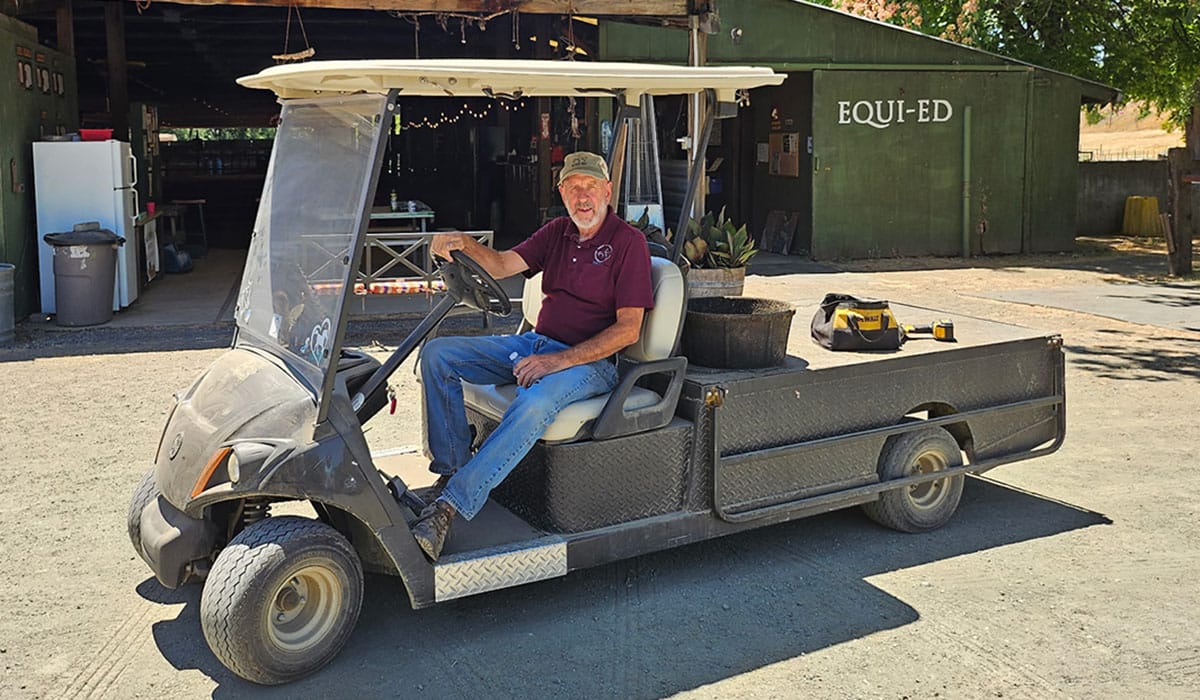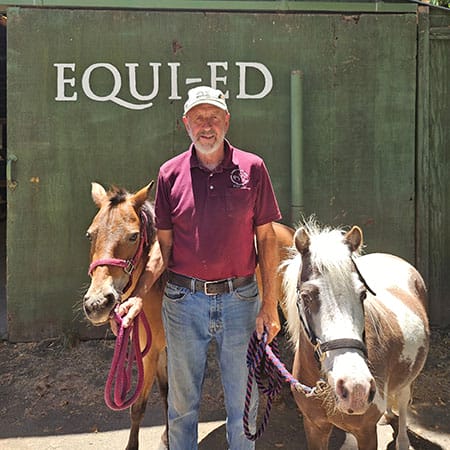Wearing Many Hats, Volunteer Keeps Therapeutic Riding Program Strong

Meet Daily Point of Light Award honoree Tom Giannini. Read his story, and nominate an outstanding volunteer or family as a Daily Point of Light.
For the past 15 years, Tom Giannini has been a quiet force behind the scenes at Equi-Ed, a therapeutic riding center in Santa Rosa, California. Having been around horses since he was a child, Tom first showed up thinking he might lend a hand with basic barn chores.
What followed was a deep and lasting commitment that’s seen him take on just about every role imaginable—horse handler, sidewalker, repairman, evening feeder, manure manager, public event helper and substitute for fellow volunteers when needed. With more than 7,800 hours of service and 1,200 miles walked beside students and horses, Tom is the kind of volunteer who makes the entire operation run more smoothly.
But what keeps him coming back isn’t just the horses—it’s the people. Before Equi-Ed, Tom had little experience with individuals with disabilities. Now, he’s the steady presence riders count on, whether they’re climbing into the saddle for the first time or building confidence with each ride. He doesn’t seek recognition, but his impact is clear: in the barn’s day-to-day rhythm, in the repaired gates and tools he’s quietly fixed, and especially in the lives of the students whose small victories he celebrates every week.
What inspired you to start volunteering with Equi-Ed?
I had just moved to Santa Rosa from the Bay Area, and most of my friends and family were still down there. I wanted something to do and remembered hearing about therapeutic riding. I’ve been around horses most of my life, so I thought maybe I had some useful ranch skills. I found Equi-Ed online and met with Maxine, who founded the program. After seeing the barn and getting to know Max and the horses, I thought, “Why not give it a try?” That was in 2010. And now, 15 years later, I’m still doing it.
What does your volunteer role involve?
A little bit of everything. I help out during lessons as a horse handler or sidewalker, feed horses on Tuesday nights and fill in when other volunteers can’t make it. I also do barn chores and fix things around the property—gates, fences, equipment, you name it. I even help when we’re out in public, like local parades or presentations to promote Equi-Ed. I guess you could say I’m kind of the handyman and go-to support guy around the barn.

What’s your favorite part about volunteering?
Just being at the barn, really. I enjoy the environment and the people. And it’s also seeing what this program does for the students—watching them improve physically and emotionally. We had one rider, James, who often comes in hunched over, but once he gets on the horse and has a good ride, you can see him sitting up straighter. It really does something for him. That kind of progress makes it worth it.
Is there a student whose progress really stuck with you?
Yeah, there’s a boy who started recently—probably around 9 years old—and he’d never been on a horse before. The first lesson, we barely got him mounted, and he just cried the whole time. Same thing the second time. He was terrified. By the third lesson, we got him to take a few steps on the horse. And then the fourth time, he just climbed right up onto the mounting block, got on the horse, and was ready to go. It was like night and day. Now he’s excited to come to lessons, and it’s just great to see that kind of change.
What do you get out of volunteering?
It’s rewarding to see how much the students benefit from riding. But it’s also the camaraderie at the barn. We all pitch in—volunteers, instructors, students’ families. Whether it’s doing lessons, fixing things or being in a parade together, there’s a strong sense of community. I enjoy being part of that.
What do you think makes therapeutic riding so effective?
I’ve heard that the movement of a horse stimulates the same muscles as walking, so it’s really good for physical therapy. But it also seems to have an emotional effect. Some students get excited just knowing they’ll be riding their favorite horse that day. You can see it in the way they greet the horse, like putting their forehead against its face.
What advice would you give to someone thinking about volunteering, especially later in life?
I’d say just give it a try. If you’re interested in helping people with physical or mental disabilities, programs like this are a great place to start. You’ll get a lot out of it, and so will the students. And if it’s not the right fit, that’s okay too. You can move onto something else.
Why is volunteering for a cause you care about important?
Because there aren’t a lot of programs like this. Especially in our area, there are only a few therapeutic riding centers around. So it’s something special, and it really makes a difference in people’s lives.
What do you hope people take away from your story?
That if you’re looking to volunteer and don’t know where to start, just go visit a place, talk to people, watch what they do. If it feels like a good fit, give it a try. You never know—you might end up staying for 15 years like I did.
Do you want to make a difference in your community like Tom? Find local volunteer opportunities.
